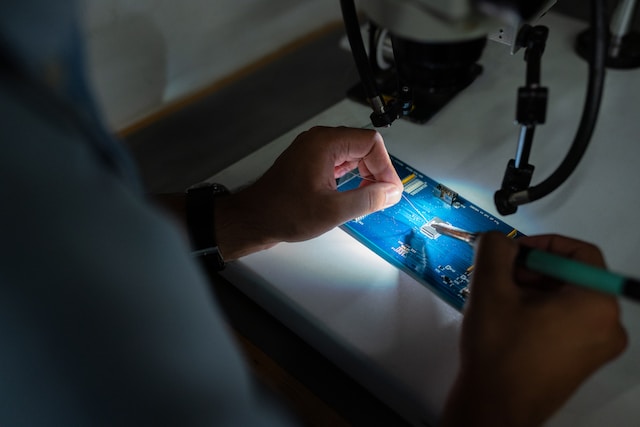At the beginning of their IoT journey, businesses are faced with a fork in the road: do they adopt existing IoT solutions, build their own, or mix and match the two?
Every IoT tech stack involves four fundamental components – hardware, software, networks and front-end applications or UIs. That’s a lot for businesses to handle in-house. A Cisco survey found that some 75% of IoT projects fail, largely due to a lack of expertise.
To counteract these challenges, IoT platforms have rocketed in popularity. They simplify many of the complex aspects of IoT development so businesses can access clean data with minimal fuss.
But is that the only way forward? Or does creating custom-built IoT solutions still hold merit?
Here, we’ll investigate the predicament of adopting existing IoT solutions vs custom-building them.
Components of an IoT tech stack

To build an IoT system, businesses need to engineer or buy the following:
- Network-enabled sensors and hardware (typically with embedded firmware, aka. embedded systems – the ‘Things’).
- Network hardware and capabilities, e.g. routers and network gateways, to authenticate and aggregate data from sensors.
- The processing layer (aka. middleware), bridges peripheral hardware with centralised systems. Stores, analyses and processes data using a variety of modules and processes, such as machine learning.
- Application layer/front-end, which ingests clean, usable data from the processing layer for use in applications, dashboards and UIs for insight, transformation and action.
So, what are the options for building an IoT tech stack?
Creating your own IoT solutions
To build a custom end-to-end IoT solution, the following tools, technologies and processes need to be developed, deployed and managed:
- Hardware
- Server deployment and maintenance
- APIs and connectivity
- Database build and maintenance
- Front-end applications and UI/UX
- Security and compliance features

For starters, engineering hardware from scratch is beyond question for most. But, fortunately, IoT hardware is relatively inexpensive and easy to install. It’s necessary to consider the interoperability and scalability of components, including any edge computing requirements.
It’s worth highlighting that businesses may own some or all of the hardware required to deploy an IoT system. For example, taxi and delivery providers like Uber pull data from the drivers’ smartphone apps. They only needed to develop the app, the middleware, and the front-end applications required to use the data.
Once hardware is secured, businesses must develop the middleware and front-end applications required to convert raw sensor data into clean, processed data for analysis, insights and action.
This is where IoT platforms can step in.
Using IoT platforms
Put simply, an IoT platform ingests data from devices and hardware, processes it, and makes it available in a format that businesses can use immediately.
Businesses require a clean, usable stream of IoT data – only then can that data be analysed, visualised, transformed and deployed into various applications, etc.

Most IoT platforms provide the following core functionality:
- Access control
- IoT sensor and device management
- Data processing
- Data storage
- Workflow automation
- Dashboards and reporting
- Some platforms, like Particle.io, also provide hardware installation and management services
IoT platforms typically provide their services on a subscription basis, and costs increase with the amount of data required, services used, etc. Costs are reasonable for small installations but can scale up rapidly, which can catch businesses out.
Anand Tamboli, author of Build Your Own IoT Platform, highlights the case of Lyft, who found itself locked into a $300 million contract with AWS for much of 2021 after their cloud costs spiralled out of control.
Many businesses are re-balancing cloud investment with investment in on-premise infrastructure to mitigate spiralling cloud costs, dubbed “reverse migration”.
The same can be said about IoT adoption – keeping some solutions in-house may prove more cost-effective in the long term.
Should you build your own IoT platform or buy?
Building your own
Broadly speaking, creating customised solutions provides greater long-term flexibility and control over hardware, software and costs. However, this comes at the cost of higher upfront investment and slower time-to-market.
Businesses with significant in-house expertise can consider building at least some in-house solutions. Many tools and technologies required to process, clean and transform IoT data are open-source, so engineering solutions can be inexpensive if the business has in-house development teams.

Additionally, those with obvious goals for their IoT deployment may not need the bells and whistles offered by complex IoT platforms and might be better off engineering their cost-effective in-house alternatives.
Mixing and matching custom-built solutions with cloud modules for complex workloads like machine learning is entirely possible.
Buying
Investing in IoT platforms as a service (PaaS) simplifies the process of developing complex middleware, accelerating time-to-market.

This is their main appeal and can prove a massive benefit to young businesses that need functional IoT solutions fast or mature businesses with large budgets who need something that “just works”.
Moreover, businesses benefit from state-of-the-art technology and service-level agreements covering various aspects of maintenance, support, security, etc.
The verdict
For businesses that need IoT but lack virtually any in-house hardware or expertise, IoT platforms are undoubtedly attractive, but that might change as they mature and platform costs climb.
Ultimately, the case for custom-built solutions varies with requirements and in-house expertise.
Build prototypes, discuss needs with developers and engineers, and gauge whether or not in-house solutions can work for now, and for the future.










